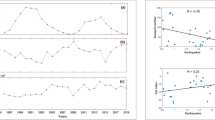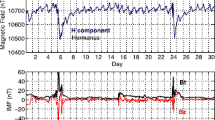Abstract
The data related to lithospheric electromagnetic emissions such as ultra low frequency (ULF, f = 0.01 Hz–10 Hz) and very low frequency (VLF, f = 3 kHz–30 kHz) emissions are analysed in relation to three major earthquakes (M = 6.8–8.5) occurred in Indian subcontinent during the years, 2011–2013. The equipments used to collect the data are thee component search coil magnetometer installed at Agra station (geographic lat. 27.2° N, long. 78° E) and indigenously developed amplitude measurements using a borehole and terrestrial antenna at Mathura station (geographic lat. 27.5° N, long. 77.68° E) about 70 km North of Agra station. The results show that ULF anomalies occur in the form of amplitude bursts 9 to 16 days prior to main shocks of the earthquakes whereas VLF amplitude anomalies occur coseismic and 3 days before recorded by the terrestrial antenna (the anomalies are weak and do not occur clearly in borehole antenna). These results suggest that ULF emissions (f < 0.1Hz) can travel to the observing station both via crustal and atmospheric regions, whereas VLF emissions can travel via atmospheric region only. The ULF data are compared with those obtained at two other stations of Shillong and Kachchh and malfunctioning of the sensors is ruled out. The effect of magnetic storms and lightning are not found to influence the data also. The precursory periods of 9–16 days are of the same order as 7–15 days reported by Singh et al. (2018) from the study of ionospheric perturbations caused by the same earthquakes. Hence, this study provides an interesting information about lithosphere–ionosphere coupling.









Similar content being viewed by others
REFERENCES
Campbell, W.H., Natural magnetic disturbances fields, not precursors, preceding the Loma Prieta earthquake, J. Geophys. Res., 2009, vol. 114, A05307.
Chauhan, V., Singh, O.P., Kushwah, V., Singh, V., and Singh, B., Ultra-low-frequency (ULF) and total electron content (TEC) anomalies observed at Agra and their association with regional earthquakes, J. Geodyn., 2009, vol. 48, pp. 68–74.
Devi, M., Barbara, A.K., Depueva, A.H., Ruzhin, Y.Y., and Depuev, V., Anomalous total electron content (TEC) and atmospheric refractivity prior to the very strong China earthquake of May 2008, Int. J. Remote Sens., 2010, vol. 31, pp. 3589–3599.
Dobrovolsky, I.P., Zubkov, S.I., and Miachkin, V.I., Estimation of the size of earthquake preparation zones, Pure Appl. Geophys., 1979, vol. 117, pp. 1025–1044.
Fraser-Smith, A.C., Bernardi, A., McGill, P.R., Ladd, M.E., Heliwell, R.A., and Villard, A.D., Jr., Low frequency magnetic field measurements near the epicenter of the Ms = 7.1 Loma-Prieta earthquake, Geophys. Res. Lett., 1990, vol. 17, pp. 1465–1468.
Fujinawa, Y. and Takahashi, K., Electromagnetic radiations at the time of Great Kurile Island earthquake of 1994, in IUGG Meeting 1995, Boulder, Colo., 1995.
Gokhberg, M.B., Gufeld, I.L., Gershenzon, N., and Pilipenko, V.A., Electromagnetic effects during rupture of Earth’s crust, Izv. Earth Phys., 1985, vol. 21, pp. 52–62.
Hayakawa, M., Earthquake Prediction with Radio Techniques, Singapore: Wiley and Sons, 2016.
Hayakawa, M. and Fujinawa, Y., Electromagnetic Phenomena related to Earthquake Prediction, Tokyo: Terra Scientific Publishing Company, 1994.
Hayakawa, M. and Hobara, Y., Current status of seismoelectromagnetics for short term earthquake prediction, Geomatics, Nat. Hazards Risks, 2010, vol. 1, no. 2, pp. 115–155.
Hayakawa, M., and Molchanov, O.A., Seismo Electromagnetics: Lithospheric–Atmospheric–Ionospheric Coupling, Tokyo: Terra Scientific Publishing Company, 2002, pp. 11–55.
Hayakawa, M., Kawate, R., Molchanov, O.A., and Yumoto, K., Results of ultra-low-frequency magnetic field measurements during the Guam earthquake of 8 August, 1993, Geophys. Res. Lett., 1996, vol. 23, pp. 241–244.
Hayakawa, M., Hattori, K., and Ohta, K., Monitoring of ULF (ultra-low-frequency) geomagnetic variations associated with earthquakes, Sensors, 2007, vol. 7, pp. 1108–1122.
Hayakawa, M., Kasahara, Y., Nakamura, T., Hobara, Y., Rozhnoi, A., Solovieva, M., and Molchanov, O.A., The correlation between ionospheric perturbations as detected by sub ionospheric VLF/LF signals and earthquakes as characterized by seismic activities, J. Atmos. Sol. Terr. Phys., 2010, vol. 72, pp. 982–987.
Hayakawa, M., Hobara, Y., Ohta, K., and Hattori, K., The ultra-low-frequency magnetic disturbances associated with earthquakes, Earthquake Sci., 2011, vol. 24, pp. 523–534.
Jain, S.K. and Singh, B., Vertical motion of low latitude F2 layers during prolonged and isolated magnetic storms, J. Geophys. Res., 1977, vol. 82, pp. 723–726.
Keller, G.V., Practical Handbook of Physical Properties of Rocks and Minerals, John Willey and Sons, 1989.
Kingsley, S. P., On the possibilities for detecting radio emissions from earthquakes, Nuovo Cimento C, 1989, vol. 12, pp. 117–120.
Kopytenko, Yu. A., Matiashvili, T.G., Voronov, P.M., Kopytenko, E.A., and Molchanov, O.A., Detection of ultra-low-frequency emissions connected with the Spitak earthquake and its aftershock activity, based on geomagnetic pulsations data at Dusheti and Vardzia observatories, Phys. Earth Plan. Int., 1993, vol. 77, pp. 85–95.
Kopytenko, Yu. A., Ismaguliov, V.S., Hattori, K., Voronov P.M., Hayakawa, M., Molchanov, O.A., Kopytenko, E.A., and Zaitsev, D.B., Monitoring of the ULF electromagnetic disturbances at the station network before Earthquake in seismic zones of Izu and Chiba peninsulas, in Seismo Electromagnetics: Lithosphere–Atmosphere–Ionosphere Coupling, Hayakawa, M. and Molchanov, O.A., Eds., Tokyo: Terra Scientific Publishing Company, 2002, pp. 11–18.
Kushwah, V., Singh, V., Singh, B., and Hayakawa, M., Ultra-low frequency (ULF) magnetic field anomalies observed at Agra and their relation to moderate seismic activities in Indian region, J. Atmos. Sol.-Terr. Phys., 2005, vol. 67, pp. 992–1001.
Kushwah, V., Singh, V., and Singh, B., Ultra-low frequency (ULF) amplitude anomalies observed at Agra (India) and their association with regional earthquakes, Phys. Chem. Earth, 2009, vol. 34, pp. 367–372.
Lakshmi, D.R., Reddy, B.M., and Sastri, S., A prediction model for equatorial low latitude HF communication parameters during magnetic disturbances, Indian J. Radio Space Phys., 1983, vol. 12, pp. 118–123.
Liu, J.Y., Chen, Y.I., Chuo, Y.J., and Tsai, H.F., Variations of ionospheric total electron content during the Chi-Chi earthquake, Geophys Res. Lett., 2001, vol. 28, no. 7, pp. 1383–1386.
Miah, M.A.W., Fundamentals of Electromagnetics, Tata McGraw-Hill Publishing Company Limited, 1982, pp. 284–285.
Mognaschi, E.R., On the possible origin, propagation and detectability of electromagnetic precursors of earthquakes, Atti Ticinensi Sci. Terra, 2002, vol. 43, pp. 111–118.
Molchanov, O.A. and Hayakawa, M., Seismo-Electromagnetics and Related Phenomena: History and Latest Results, Tokyo: Terra Scientific Publishing Company, 2008.
Nakamura, T., Korepanov, V., Kasahara, Y., Hobara, Y., and Hayakawa, M., An evidence on the lithosphere–ionosphere coupling in terms of atmospheric gravity waves on the basis of a combined analysis of surface pressure, ionospheric perturbations and ground-based ULF variations, J. Atmos. Electr., 2013, vol. 33, no. 1, pp. 53–68.
Ohta, K., Umeda, K., Watanabe, M., and Hayakawa, M., Relationship between ELF magnetic field and Taiwan earthquake, in Lithosphere–Atmosphere–Ionosphere Coupling, Hayakawa, M. and Molchanov, O.A., Eds., Tokyo: Terra Scientific Publishing Company, 2002, pp. 233–237.
Pulinets, S., Ionospheric precursors of earthquakes: Recent advance in theory and practical, Terr. Atmos. Ocean. Sci., 2004, vol. 15, no. 3, pp. 413–435.
Pulinets, S.A. and Boyarchuk, K.A., Ionospheric Precursors of the Earthquakes, Berlin: Springer, 2004.
Pulinets, S.A. and Ouzounov, D., The Possibility of Earthquake Forecasting, Bristol, UK: IOP, 2018.
Pulinets, S.A., Ouzounov, D.P., Karelin, A.V., and Davidenko, D.V., Physical bases of the generation of short-term earthquake precursors: A complex model of ionization-induced geophysical processes in the lithosphere–atmosphere–ionosphere–magnetosphere system, Geomagn. Aeron. (Engl. Transl.), 2015, vol. 55, no. 4, pp. 521–538.
Qian, S., Hao, J., Zhou, J., and Gao, J., Simulating experimental study on ULF 681 electromagnetic precursors before Jiji M s = 7.4 earthquake, in Lithosphere–Atmosphere–Ionosphere Coupling, Hayakawa, M. and Molchanov, O.A., Eds., Tokyo: Terra Scientific Publishing Company, 2002, pp. 49–53.
Schekotov, A., Fedorov, E., Hobara, Y., and Hayakawa, M., ULF magnetic field depression as a possible precursor to the 2011/3.11 Japan earthquake, J. Atmos. Electr., 2013, vol. 33, no. 1, pp. 41–51.
Singh, B. and Pundhir, D., Some results of Schumann Resonance studies at a low latitude station Agra, India during post period of solar cycle minimum 2008–2009, Indian J. Radio Space Phys., 2014, vol. 43, pp. 325–332.
Singh, B., Tyagi, R., Hobara, Y., and Hayakawa, M., X-rays and solar proton event induced changes in the first mode Schumann resonance frequency observed at a low latitude station Agra, India, J. Atmos. Sol.-Terr. Phys., 2014, vol. 113, pp. 1–9.
Singh, D., Singh, B., and Pundhir, D., Ionospheric perturbations due to earthquakes as determined from VLF and GPS-TEC data analysis at Agra, India, Adv. Space Res., 2018, vol. 16, pp. 1952–1965.
Singh, R.P. and Singh, B., Anomalous subsurface VLF electric field changes related to India–Nepal Border earthquake (M = 5.3) of 4 April 2011 and their lithosphere–atmosphere coupling observed at Mathura. J. Atmos. Electr., 2013, vol. 33, pp. 31–39.
Singh, R.P., Singh, B., Bansal, V., and Hayakawa, M., VLF electromagnetic noise bursts related to major seismic activities observed at Agra, J. Atmos. Electr., 2000, vol. 20, no. 1, pp. 7–20.
Singh, R.P., Mishra, P.K., and Singh, B., Anomalous VLF electric field perturbations associated with Chamoli earthquakes of March/April 1999, Curr. Sci., 2001, vol. 80, no. 11, pp. 101–106.
Singh, R.P., Singh, B., Mishra, P.K., and Hayakawa, M., On the lithosphere–atmosphere coupling of seismo–electromagnetic signals, Radio Sci., 2003, vol. 38, no. 4, pp. 1–10.
Singh, R.P., Kumar, M., Singh, O.P., and Singh, B., Subsurface VLF electric field emissions associated with regional earthquakes, Indian J. Radio Space Phys., 2009, vol. 38, pp. 220–226.
Singh, V., Singh, B., Kumar, M., and Hayakawa, M., Identification of earthquake sources responsible for subsurface VLF electric field emissions observed at Agra, Phys. Chem. Earth, Parts A/B/C, 2006, vol. 31, nos. 4–9, pp. 325–335.
Surkov, V.V., ULF electromagnetic perturbations resulting from the fracture and dilatancy in the earthquake preparation zone, in Atmospheric and Ionospheric Electromagnetic Phenomena Associated with Earthquakes, Hayakawa, M., Ed., Tokyo: Terra Scientific Publishing Company, 1999, pp. 371–382.
Swati, Singh, B., Pundhir, D. Sinha, A.K., Rao, K.M., Guha, A., and Hobara, Y., Ultra-low frequency (ULF) magnetic field emissions associated with some major earthquakes occurred in Indian Subcontinent, J. Atmos. Sci. Terr. Phys., 2020, vol. 211, pp. 1–19.
Thomas, J.N., Love, J.J., and Johnston, M.J.S., On the reported magnetic precursor of the 1989 Loma Prieta earthquake, Phys. Earth Planet. Int., 2009a, vol. 173, pp. 207–215. https://doi.org/10.1016/jpepi-2008.11.014
Thomas, J.N., Love, J.J., and Johnston, M.J.S., On the reported magnetic precursor of the 1993 Guam Earthquake, Geophys. Res. Lett., 2009b, vol. 36, L13601. https://doi.org/10.1029/2009GL039020
Tsarev, V.A. and Sasaki, H., Low frequency seismogenic electromagnetic radiation: How does it propagate in the Earth’s crust and where it can be detected?, in Atmospheric and Ionospheric Electromagnetic Phenomena Associated with Earthquakes, Hayakawa, M., Ed., Tokyo: Terra Scientific Publishing Company, 1999, pp. 383–393.
Yumoto, K., Ikemoto, S., Cardinal, M.G., Hayakawa, M., Hattori, K., Liu, J.V., Saroso, S., Ruhimat, M., Husni, M., Widarto, D., Ramos, E., McNamara, D., Otadoy, R.E., Yumul, G., Ebora, R., and Servando, N., A new ULF wave analysis for seismo–electromagnetics using CPMN/MAGDAS data, Phys. Chem. Earth, 2009, vol. 34, pp. 360–366.
ACKNOWLEDGMENTS
The authors are thankful to the Directors of IIG, Mumbai and ISR, Gandhinagar for providing the ULF data and Heads of other institutes for providing facilities for this research work. Thanks are also due to the Editor for his support in systematic and fast processing of the paper. Authors are highly thankful to the esteemed referee for their suggestions which enhanced the quality of the paper.
Funding
Authors are grateful to Ministry of Earth Sciences, Govt. of India for their financial support in the form of a research project.
Author information
Authors and Affiliations
Corresponding author
Rights and permissions
About this article
Cite this article
Sarita Sharma, Swati, Singh, R.P. et al. Lithospheric Electromagnetic Emissions Associated with Some Major Earthquakes Occurred in Indian Subcontinent. Geomagn. Aeron. 61, 619–631 (2021). https://doi.org/10.1134/S0016793221040150
Received:
Revised:
Accepted:
Published:
Issue Date:
DOI: https://doi.org/10.1134/S0016793221040150




